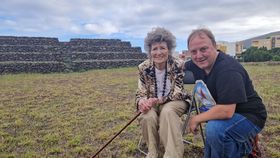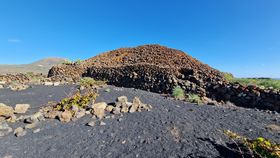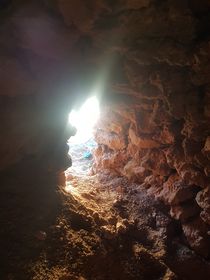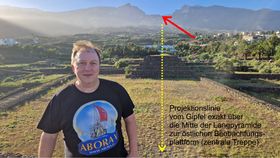Erfolgreiche Kanaren-Exkursion mit Jacqueline Heyerdahl: Unterschied zwischen den Versionen
RMH (Diskussion | Beiträge) (Die Seite wurde neu angelegt: „'''(dg)''' '''1994 reiste ich das erste Mal auf die [https://de.wikipedia.org/wiki/Kanarische_Inseln Kanaren]. Damals auf Einladung von…“) |
RMH (Diskussion | Beiträge) |
||
| Zeile 41: | Zeile 41: | ||
We made another amazing observation in Guiteza. But I will describe this report in the next post. (to be continued …) | We made another amazing observation in Guiteza. But I will describe this report in the next post. (to be continued …) | ||
| + | |||
| + | ([[Erfolgreiche Kanaren-Exkursion mit einer bedeutenden Entdeckung (Teil 2)|Zu Teil 2 / To part 2])) | ||
Version vom 14. Dezember 2022, 10:54 Uhr
(dg) 1994 reiste ich das erste Mal auf die Kanaren. Damals auf Einladung von Thor Heyerdahl. Er wollte nach meinem erfolgreichen Dilmun III Experiment unbedingt wissen, wie ich es schaffte auf der Ostsee gegen den Wind zu segeln. Heute – 28 Jahre später – ging es mir um völlig andere Themen. Das Hauptziel war ein Gespräch mit der Witwe Jacqueline Heyerdahl sowie Drehs an verschiedenen Plätzen mit hoher archäologischer Bedeutung auf Teneriffa und Lanzarote.
Bereits am Dienstag empfing uns Jaqueline Heyerdahl und David V. Ortiguez (Wissenschaftlicher Leiter) im Pyramidenpark Güimar/Teneriffa. An den großen Stufenpyramiden interviewten wir Jaqueline. Sie war von den Informationen über die neue ABORA V Expedition überwältigt. Auf dem Weg zur Sonnen-Stufenpyramide übergab sie mir symbolisch den „Staffelstab“, um mit der geplanten ABORA V Expedition das Vermächtnis ihres Mannes zu erfüllen. Es war ein sehr emotionales Moment, den wir für unseren Doku festhielten.
Anschließend führte ich den Chefarchäologen zu einer spannenden Beobachtung. An einem kleinen unscheinbaren Stufenturm fiel mir eine kleine Nische auf. Bei Begutachtung entpuppte sie sich als Portal, das einen mythischen Seelenein- oder Ausgang repräsentiert. Der Leiter von Institutum Canarium Hans-Jürgen Ulrich instruierte mich, um nach diesen architektonischen Strukturen Ausschau zu halten. Er erforscht diese Nischen seit vielen Jahren nicht nur auf den kanarischen, sondern auch auf den mittelmeerländischen sowie azorischen Stufenbauten. Weitere Ähnlichkeiten, wie z.B. Wendelrampen und ihre astronomische Ausrichtung, stellen diese Bauwerke in eine homologe Reihe. Das heißt, sie weisen auf einen gemeinsamen kulturellen Ursprung hin!
Gleiches gilt für einen relativ „neu entdeckte“ Stufenbau auf Lanzarote. Diesen erkundeten wir zwei Tage später gemeinsam mit Ramon Zürcher ABORA & A.A.S.-Team) auf das Vorhandensein ähnlicher Strukturen. Die Überraschung war groß, dass wir nicht nur die gleichen Nischen vorfanden, sondern hinter einer sogar eine kleine Kammer mit einem Bienenkrag-Gewölbe entdeckten! Ein fast baugleiches Gewölbe hatten wir einen Tag zuvor nahe dem Gräberfeld von Quiquere (Lanzarote) in einer Einstufen-Plattform vorgefunden. Außerdem ragten dort dutzende Tumuli in den Himmel. Fast alle mit Nischen als „Seelentore“ ausgestattet. Das nächste Highlight war die kleine Stufenpyramide von Maguez. Sie wies sowohl die Nischen als auch einen kleinen Gang mit einer Kammer auf. Das war sehr erstaunlich, da ich dieses architektonische Merkmal auch von der Azoreninsel Pico sowie von Sizilien kenne! Diese Beobachtungen untermauert unsere Auffassung, dass wir es bei diesen Stufenbauten nicht mit landwirtschaftlichen Anlagen zu tun haben. Vielmehr müssen sie das Vermächtnis älterer Kulturen sein, die diese Stufenbauten als sakrale Architektur errichteten.
Eine weitere erstaunliche Beobachtung machten wir in Guiteza. Aber diesen Bericht schildere im nächsten Post. (wird fortgesetzt …)
Der Stufenbauten von Güimar. Die beiden kleinen Stufenpyramiden rahmen den östlichen Komplex ein. Dort kann man bei der Tag-Nacht-Gleiche – und nur von dort (präzise berechnet) – einen doppelten Sonnenuntergang im westlichen Gebirgshorizont beobachten! Welcher spanische Bauer wollte diese solare Ausrichtung in seine angebliche landwirtschaftliche Anlage integrieren? Und vor allem auch warum? //
The stepped buildings of Güimar. The two small step pyramids frame the eastern complex. There you can observe a double sunset in the western mountain horizon at the equinox - and only from there (precisely calculated)! What Spanish farmer wanted to incorporate this solar orientation into his supposed agricultural layout? And above all why?Auf dem Weg zur „Sonnen-Pyramide“ überreichte mir Jacqueline Heyerdahl symbolisch den Staffelstab für die nächste Expedition. Trotz Bänderdehnung im rechten Fußgelenk erklomm sie mit mir die Stufenpyramide. Gemeinsam erinnerten wir uns an die Zeit, als Thor noch mit uns das Zikkurat bestieg … //
On the way to the “Pyramid of the Sun”, Jacqueline Heyerdahl symbolically handed me the baton for the next expedition. Despite stretching the ligaments in her right ankle, she climbed the step pyramid with me. Together we remembered the time when Thor climbed the ziggurat with us...Das erste Mal mit von der Partie war mein ABORA-Vereinsmitglied Ramon Zürcher. Gemeinsam wollen wir in den nächsten Jahren einen eigenen YouTube-Kanal aufbauen. Er wird unter dem Titel „Ancient Connections“ bald online gehen. Bitte helft, dieses Format in Bälde mit einem ABO zu unterstützen!!! //
My ABORA club member Ramon Zürcher was there for the first time. Together we want to set up our own YouTube channel in the next few years. It will soon be online under the title "Ancient Connections". Please help to support this format soon with an ABO!!!Fast unsichtbar im Pyramidenfeld von Güimar steht am Nordrand ein kleinerer Stufenbau, der eine religiöse Nische aufweist. Die meisten Besucher und auch die dortigen Archäologen schenken dieser unauffälligen Struktur keine Bedeutung. Dabei ist sie einem Fingerabdruck gleichzusetzen, den wir auch von weitentfernt stehenden Stufenbauten des Altertums kennen. //
Almost invisible in the pyramid field of Güimar there is a smaller stepped building on the northern edge, which has a religious niche. Most visitors, as well as archaeologists there, pay no attention to this inconspicuous structure. It can be equated with a fingerprint, which we also know from far-off stepped structures of antiquity.Die Stufenpyramide von Maguez. Dieser 13 m lange und etwa 6 m hohe Bau wirkt auf den ersten Blick wenig spektakulär. Dafür brilliert dieses Mini-Zikkurat mit mehreren Nischen und einer kleinen Kammer mit Bienenkorbgewölbe. //
The step pyramid of Maguez. At first glance, this 13 m long and around 6 m high building does not appear very spectacular. But this mini ziggurat shines with several niches and a small chamber with a beehive vault very interesting.Blick auf das Eingangsportal auf der Nordseite. Solche Strukturen hatte der portugiesische Archäologe Nunon Ribeiro auch auf der Azoreninsel Pico entdeckt. Darin fand er sogar Keramikreste, die angeblich auf etwa 2.300 v. Chr. datiert wurden sein sollten. //
View of the entrance portal on the north side. The Portuguese archaeologist Nunon Ribeiro also discovered such structures on the Azores Island of Pico. In it he even found remains of ceramics that are said to date back to around 2,300 B.C.Noch einmal der Blick von der kleinen „Sonnen“-Pyramide auf den Zeremonialplatz und die doppelte Langpyramide. Im Hintergrund der Gebirgshorizont mit dem auffälligen Zacken im Kerbtal. Dort findet der „doppelte Sonnenuntergang“ am Tag zur Tag-Nacht-Gleichen statt. Nach Aussage von David Ortiz kann man dieses solare Ereignis (roter Pfeil) nur von hier oben und nur auf der obersten Plattform dieses Zikkurats beobachten! Das wäre dann schon ein erstaunliches Ereignis – codiert in monumentaler Architektur! //
Once again the view from the small "sun" pyramid to the ceremonial square and the double long pyramid. In the background the mountain horizon with the conspicuous peaks. There the "double sunset" takes place during the day at the day-night equinox. According to David Ortiz, this solar event (close to the red arrow) can only be observed from up here and only on the top of this platform! That would be an amazing event - encoded in monumental architecture!
+++++++++++++++++++++++++++++
Successful Canary Islands excursion with Jacqueline Heyerdahl
In 1994 I traveled to the Canary Islands for the first time. Back then at the invitation of Thor Heyerdahl. After my successful DILMNUN III experiment, he really wanted to know how I managed to sail against the wind on the Baltic Sea. Today – 28 years later – I was concerned with completely different topics. The main goal was a conversation with the widow Jacqueline Heyerdahl and shooting at different places with high archaeological importance in Tenerife and Lanzarote.
Jaqueline Heyerdahl and David V. Ortiguez (scientific director) received us on Tuesday in the pyramid park Güimar/Tenerife. At the large step pyramids we interviewed Jaqueline. She was overwhelmed by the information about the new ABORA V expedition. On the way to the step pyramid of the sun, she symbolically handed me the baton to fulfill her husband's legacy with the planned ABORA V expedition. It was a very emotional moment that we captured for our documentary.
I then led the chief archaeologist to an exciting observation. I noticed a small niche on a small, inconspicuous stepped tower. Upon inspection, it turned out to be a portal representing a mythical entrance or exit of the soul. The director of Institutum Canarium Hans-Jürgen Ulrich instructed me to look out for these architectural structures. He has been researching these niches for many years not only on the Canary, but also on the Mediterranean and Azores stepped structures. Other similarities, such as spiral ramps and their astronomical alignment, place these structures in a homologous series. That is, they indicate a common cultural origin!
The same applies to a relatively "newly discovered" step structure on Lanzarote. Two days later we explored this together with Ramon Zürcher (ABORA & A.A.S. team) for the presence of similar structures. The surprise was great that we not only found the same niches, but also discovered a small chamber with a beehive vault behind one! A day earlier we had found an almost identical vault in a single-stage platform near the burial ground of Quiquere (Lanzarote). There were also dozens of tumuli towering up into the sky. Almost all equipped with niches as "soul gates". The next highlight was the small step pyramid by Maguez. It featured both the niches and a small corridor with a chamber. This was very amazing as I also know this architectural feature from the Azores island of Pico as well as from Sicily! These observations support our view that these stepped structures are not agricultural structures. Rather, they must be the legacy of older cultures that erected these tiered structures as sacred architecture.
We made another amazing observation in Guiteza. But I will describe this report in the next post. (to be continued …)
([[Erfolgreiche Kanaren-Exkursion mit einer bedeutenden Entdeckung (Teil 2)|Zu Teil 2 / To part 2]))






